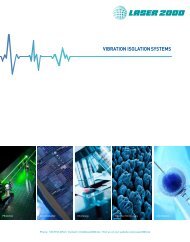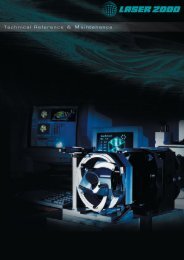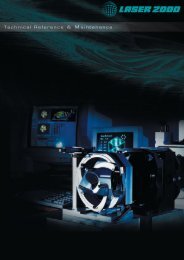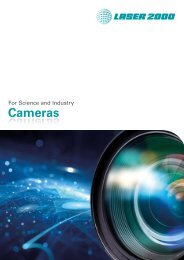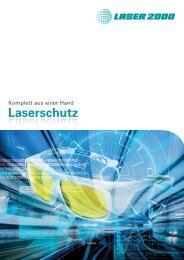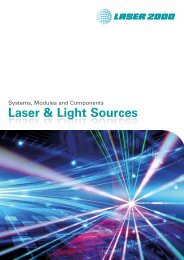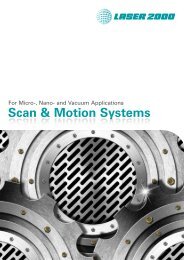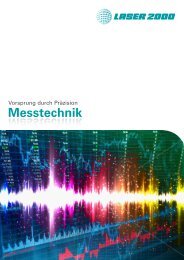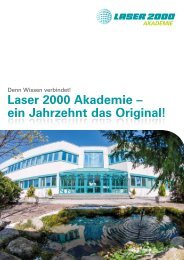Semrock Master Catalog 2018
Semrock Master Catalog 2018
Semrock Master Catalog 2018
You also want an ePaper? Increase the reach of your titles
YUMPU automatically turns print PDFs into web optimized ePapers that Google loves.
Fluorophores<br />
Single-band<br />
Sets<br />
Multiband<br />
Sets<br />
Cubes Laser<br />
Sets<br />
NLO<br />
Filters<br />
Individual<br />
Filters<br />
Dichroic<br />
Beamsplitters<br />
Tunable<br />
Filters<br />
Introduction to Fluorescence Filters<br />
Optical fluorescence occurs when a molecule absorbs light at wavelengths within its absorption band, and<br />
then nearly instantaneously emits light at longer wavelengths within its emission band. For analytical purposes,<br />
strongly fluorescing molecules known as fluorophores are specifically attached to biological molecules and<br />
other targets of interest to enable identification, quantification, and even real-time observation of biological and<br />
chemical activity. Fluorescence is widely used in biotechnology and analytical applications due to its extraordinary<br />
sensitivity, high specificity, and simplicity.<br />
Most fluorescence instruments, including fluorescence microscopes, are based on optical filters.<br />
A typical system has three basic filters: an excitation filter (or exciter), a dichroic beamsplitter (or<br />
dichromatic mirror), and an emission filter (or barrier filter). The exciter is typically a bandpass<br />
filter that passes only the wavelengths absorbed by the fluorophore, thus minimizing excitation of<br />
other sources of fluorescence and blocking excitation light in the fluorescence emission band. The<br />
dichroic is an edge filter used at an oblique angle of incidence (typically 45°) to efficiently reflect light<br />
Filter Transmission<br />
TECHNICAL NOTE<br />
excitation<br />
filter<br />
sample<br />
absorption<br />
Wavelength of Light<br />
dichroic<br />
beamsplitter<br />
emission<br />
filter<br />
sample<br />
fluorescence<br />
in the excitation band and to transmit light in the emission band. The<br />
emitter is typically a bandpass filter that passes only the wavelengths emitted by the<br />
fluorophore and blocks all undesired light outside this band – especially the excitation<br />
light. By blocking unwanted excitation energy (including UV and IR) or sample and system<br />
autofluorescence, optical filters ensure the darkest background.<br />
An appropriate combination of optical filters, making up a filter set, enables the<br />
visualization of a given fluorophore. See pages 10-13 for a listing of popular fluorophores<br />
and corresponding filter sets that can be used to image these fluorophores. A filter set<br />
needs to be optimized not only for imaging of distinct fluorophores but also designed to<br />
image a given fluorophore under different experimental conditions.<br />
Most of <strong>Semrock</strong> filter sets are a balance between high-brightness and<br />
high-contrast. These filter sets are the best choice of filters under standard<br />
imaging conditions. However, when the signal level from a sample is low,<br />
sets with wider passbands of the excitation and emission filters enable<br />
maximum signal collection efficiency. Studies such as imaging of single<br />
molecules typically utilize a filter set with a wide passband or a long pass<br />
emission filter. In studies utilizing such filter sets, it is required to maintain<br />
very low background autofluorescence signal by means of appropriate<br />
sample preparation protocols. However, since the wide passbands of such<br />
filter sets occupy a large spectral bandwidth, such filters are not preferred<br />
in multiplexing assays when imaging of several fluorophores is required.<br />
Filter sets with narrower passbands are preferred options when imaging a<br />
sample labeled with multiple fluorophores. Such filter sets reduce crosstalk<br />
between multiple fluorophores. Narrower passbands allow only the<br />
strongest portion of the fluorophore emission spectrum to be transmitted,<br />
reduce autofluorescence noise and thus improve the signal-to-noise ratio<br />
in high background autofluorescence samples. Such filter sets are ideal for<br />
samples with ample fluorescent signal level.<br />
In most fluorescence instruments, the best performance is obtained with<br />
thin-film interference filters, which are comprised of multiple alternating thin<br />
layers of transparent materials with different indices of refraction on a glass<br />
substrate. The complex layer structure determines the spectrum of light<br />
transmission by a filter. Thin-film filters are simple to use, inexpensive, and<br />
provide excellent optical performance: high transmission over an arbitrarily<br />
determined bandwidth, steep edges, and high blocking of undesired light<br />
over the widest possible wavelength range.<br />
FITC-5050A “High Brightness” Filter Set<br />
100<br />
90<br />
80<br />
70<br />
145%<br />
60<br />
50<br />
100%<br />
71%<br />
40<br />
30<br />
Brightness Contrast<br />
20<br />
10<br />
0<br />
400 450 500 550 600 650<br />
Wavelength (nm)<br />
Advances in thin-film filter technology pioneered by <strong>Semrock</strong>, and embodied in all BrightLine filters, permit even higher<br />
performance while resolving the longevity and handling issues that can plague filters made with older soft-coating<br />
technology. This advanced technology is so flexible that users have a choice between the highest-performance BrightLine<br />
filter sets and the best-value BrightLine Basic <br />
filter sets.<br />
Transmission (%)<br />
Transmission (%)<br />
100<br />
90<br />
80<br />
70<br />
60<br />
50<br />
40<br />
30<br />
20<br />
10<br />
FITC-2024B “High Contrast” Filter Set<br />
100%<br />
0<br />
400 450 500 550 600<br />
Wavelength (nm)<br />
57%<br />
Brightness Contrast<br />
650<br />
140%<br />
More<br />
14



